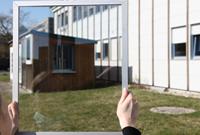Ultra-Slim Vacuum Glazing for Optimum Thermal Insulation

The situations in which vacuum insulation glazing can be used are many and varied. In the main, it is suitable for windows, facades and roof coverings in commercial and private buildings. Other areas of application include mobile situations, where low weight, slender systems and excellent insulation values are required. A logical complement to this work on vacuum glazing is the parallel development of frames with high thermal-insulation values (HWFF 2008). Bearing the name TopTherm 90, the first model windows were shown at the glasstec in Düsseldorf in 2008. Thanks to new production methods, the Uf value of Top Therm 90 (with a constructional depth of only 90 mm) is less than 0.8 W/m²K.
Dr Hans-Peter Ebert is head of the ¬department for functional materials in energy technology at the Bavarian Centre for Applied Energy Research (ZAE) in Würzburg.
Sven Hippeli is a research assistant at the ZAE.
Dr Helmut Weinläder is head of the working group for energy-efficient buildings at the ZAE.
Finally the foil is welded on to the rear face in an airtight form in a vacuum chamber. With this type of construction, Ug values of 0.5 W/m²K can be achieved. Tests carried out on the sample panes have confirmed the mechanical stability and the airtight quality of the edge seal. In terms of mechanical loading, too, the vacuum glazing was able to resist the same thermal tensions as conventional insulating double glazing. In addition to float glass, safety glasses (toughened glass and laminated safety glass) are suitable for use in this form of construction. By 2011, suitable production techniques will also be available, whereby the price of vacuum insulating glazing should not be any higher than that for conventional triple glazing.
Technically speaking, the production of vacuum insulation glazing depends on evacuating the gas from the cavity between the panes and thus reducing the pressure to levels below 10-3 mbar. As a result of the external atmospheric pressure that is caused by the evacuation of the cavity, the panes of glass are subject to a load of 10 tonnes per square metre. To prevent the panes being pressed together, small supports or spacers must be incorporated at regular intervals in the barely 1 mm cavity. With the support of the BMWi, German partners from the realm of research and industry recently developed an alternative concept for the edge fixing with vacuum insulation glazing, as a result of which large-scale, cost-effective technical production is almost within reach. This concept foresees the use of layers of metal foil, which are applied to the panes of glass in a cold soldering process that avoids damaging the sensitive low-E layers.
In view of the relatively low weight, this provides planners and architects with new scope for designing slim and aesthetically pleasing glazed facades – for which, of course, the appropriate forms of frame construction are necessary: slender, lightweight and with high insulation properties. For that reason, two research projects are being undertaken with the support of the Federal German Ministry for Economics and Technology (BMWi) in which production techniques are being developed for the manufacture of vacuum insulation glazing (VIG 2008) and innovative concepts for window frames (HWFF 2008). Initially, the aim of these measures is to create complete system solutions in the form of a slender, highly insulating window for the future.
With the proposed tightening of energy-saving regulations, today’s windows with conventional double glazing and Ug values of 1.0 W/m²K will no longer meet thermal-insulation requirements in a few years. Triple glazing provides adequate insulation values (with an argon filling and two low-E layers, for example, Ug = 0.7/Wm²K), but it results in a 50 per cent greater weight and large system thicknesses of between 30 and 50 mm.
Vacuum insulation glazing marks a new approach. Whereas the insulation effect at the transition from double to triple glazing is the outcome of greater system thicknesses, in the case of vacuum glazing a genuine qualitative improvement is achieved by obviating the thermal conduction caused by the gas in the cavity between the panes. Using this form of construction, even with double glazing, excellent insulation values of Ug = 0.5/m²K can be achieved with system thicknesses of less than 10 mm.
